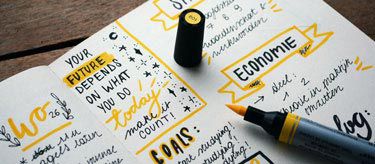The basics of envelope budgeting
Paper-based envelope budgeting might seem old-fashioned, but the principles behind it still hold water in the digital world. Learn more here.
Everyone says that it's smart to budget, but few admit how hard it can be to do something so seemingly simple. "Spend less than you earn" is usually less straightforward than it looks on paper, and even though developing a budget is vital to keeping your financial health in check, most people struggle to really stick to it. It's all too easy to accidentally splurge and end up way outside of your budget.
Sometimes, don't you wish you had something to keep you within your set limits?
That's just what envelope budgeting offers.
What is envelope budgeting?
This classic budgeting framework originated long before the age of online transfers, mobile bank accounts, and direct debits. That makes it the perfect analogue alternative to digital budgeting systems and apps.
What does it involve? There are three basic steps:
- Take paper envelopes (one for each of your spending categories) and label them, including the amount of cash allocated toward it.
- As you get paid, put the money needed to cover the expense into each envelope.
- When bills are due or you spend on a given category, use the cash from the corresponding envelope to pay. That's it!
Envelope budgeting in action
When you use this system, the standard budgeting principles still apply. Prioritize envelopes to cover your main fixed expenses — the bills that don't change (think rent, car payments, or student loans). Say your fixed expenses include $2,200 for rent, $400 for car payments and car insurance, and $300 for student loan payments each month. In this example, your fixed monthly expenses total $2,900, so you'd allocate money to the envelopes for those expenses first.
Next, allocate money to your variable expenses, the costs that fluctuate from month to month. Withdraw the total needed for your variable expenses from your bank as cash. Then, put the appropriate amount into an envelope for each category of spending.
Say you have $600 left after paying for your fixed expenses. Your discretionary expenses might include:
- Groceries
- Clothing
- Entertainment
- Short-term savings
You would then split the $600 between the four envelopes, say $450 for groceries, $50 for clothes, $50 for entertainment, and $50 for savings.
How does budgeting with envelopes help?
A key feature of this budgeting method is that once an envelope is empty, it's empty: you have to wait until the following month to spend more in that category. This forces you to know your budget ahead of time and then stay within it, two of the building blocks of personal money management. No more dipping into your savings because you overspent on a new pair of shoes. If you want to buy something in a given category, you're forced to save month after month until you have enough money in that envelope to afford it.
As a bonus, when you pay with cash instead of with a credit card or debit card, you may be more likely to spend less overall, since a dwindling stack of cash is a strong visual reminder of how much money is really leaving your pocket.
Envelope budgeting in the digital age
Although the envelope method of budgeting has been popular in the past as a way of teaching people how to budget money better, today it might seem a little old-fashioned. But the idea behind envelope budgeting can also work without physical cash. You could apply the traditional envelope method to your online chequing and savings accounts and treat them as digital envelopes. In this setup, you might keep a total (going by the previous example, $2,900) in a chequing account to pay for your monthly fixed expenses. Then, either once a month or on your payday, you could automatically transfer money to four other online savings accounts that act as digital envelopes, one for each of your variable expenses: $450 for groceries and $50 each for clothing, entertainment, and short-term savings.
You can also combine physical envelopes with online accounts. To meet these options in the middle, withdraw the total cash amount to cover all of your variable expenses once a month. Then, split the cash between paper envelopes for expenses like groceries, bus fare, or entertainment. Keep a few digital accounts to go toward property taxes, your emergency fund, or your vacation savings.
Whether you use the traditional paper envelope method, a digital envelope method, or a combination of the two, this budgeting framework can help keep you accountable as you get on top of your finances. Identify the amount of each monthly expense, allocate money towards it, and don't spend more than that. Once you master this, you'll have a better mind for when you're about to overspend. But until then, let the envelopes do your organizing for you.

